Flood Risk Assessment Based on a Cloud Model in Sichuan Province, China
Abstract
:1. Introduction
2. Related Work
3. Materials and Methods
3.1. An Overview of the Study Area
3.2. The Establishment of the Sichuan River Basin Flood Evaluation Indicator System
3.2.1. Hazard Indicators of Disaster-Causing Factors
- (1)
- Precipitation in the past 1 h
- (2)
- Precipitation for the previous 12 and 24 h
- (3)
- Precipitation for the past 5 days
3.2.2. Indicators of the Disaster-Conceiving Environment
- (1)
- River network density
- (2)
- Topographic factors
- (3)
- Factors of secondary geological disasters
3.2.3. Indicators of Exposure to Disaster-Bearing Bodies
- (1)
- Population density and distribution
- (2)
- GDP density and distribution
- (3)
- Facilities and assets such as roads
- (4)
- Hazardous chemical enterprises.
3.2.4. Indicators of Regional Disaster Resilience
3.3. Data Collection and Processing
- The basic geographic data, including river network and water system data, administrative divisions, etc., were obtained from the National Catalogue Service for Geographic Information (NCSGI) of China, in which the final river data used were obtained via DEM correction based on vector river data.
- Elevation data were 12.5 m resolution DEM data downloaded from the U.S. Geological Survey (USGS).
- Meteorological data on precipitation were obtained from the China Meteorological Data Sharing Service Network.
- Socio-economic data were obtained from the Sichuan Statistical Yearbook of the Sichuan Provincial Bureau of Statistics.
3.4. A Quantitative Assessment of Flood Risk Based on Cloud Modeling and the Entropy Weighting Method
- (1)
- Set the factor area and comment area of the evaluation object
- (2)
- Calculate expectation, entropy, and super entropy
- (3)
- Calculate indicator membership degree
- (4)
- Using entropy weight method to determine the weights of indicators
- (5)
- Calculate fuzzy subsets
4. Case Studies and Results
5. Discussion
5.1. Analysis of the Results
5.2. Advantages and Limitations
6. Conclusions and Future Work
- (1)
- We comprehensively considered the causes of disaster losses and the formation mechanisms of floods; we analyzed the disaster-causing factors, disaster-conceiving environments, disaster-bearing bodies, and the regional disaster response capacity; and we established a flood risk level assessment indicator system. A more complete, reliable and timely indicator system was constructed by increasing the indicators of human impact indicators and increasing the weight of rainfall indicators, which could realize the real-time risk assessment of daily flooding.
- (2)
- A comprehensive assessment model based on cloud modeling, entropy value, and GIS technology was constructed. The entropy weighting method could objectively evaluate the weights of the indicators, and the cloud model could realize the uncertainty mapping from the quantitative value of each indicator to the qualitative assessment level, which could be used to quantitatively predict and assess the risk of continuous flooding.
- (1)
- Since remote sensing data products can provide input parameters for distributed hydrologic models, future studies will use the kilometer-scale grid as the unit of calculation instead of county-level administrative divisions, and remote sensing data products such as land cover and evapotranspiration data will be added to disaster-conceiving environmental indicators to further improve the accuracy of the assessment.
- (2)
- We will further identify high-risk areas and propose countermeasures by simulating and extrapolating the flood inundation process under different scenarios.
- (3)
- Since there are some emerging spatiotemporal models, such as machine learning models and social media data—such as Twitter data—which are used in other applications (e.g., land use suitability analysis, post-earthquake building usability assessment, estimation of local-scale domestic electricity energy consumption) [36,37,38], we will try to apply these emerging models to flood risk assessment in the future.
Author Contributions
Funding
Institutional Review Board Statement
Informed Consent Statement
Data Availability Statement
Acknowledgments
Conflicts of Interest
References
- UN Department of Humanitarian Affairs. Internationally Agreed Glossary of Basic Terms Related to Disaster Management. Available online: https://reliefweb.int/report/world/internationally-agreed-glossary-basic-terms-related-disaster-management (accessed on 26 August 2023).
- IPCC. Climate Change 2014: Impacts, Adaptation, and Vulnerability. Part A: Global and Sectoral Aspects; Contribution of Working Group II to the Fifth Assessment Report of the Intergovernmental Panel on Climate Change; Cambridge University Press: Cambridge, UK; New York, NY, USA, 2014. [Google Scholar]
- de León, J.C.V.; Bogardi, J.; Dannenmann, S.; Basher, R. Early warning systems in the context of disaster risk management. Entwickl. Ländlichen Raums 2006, 2, 23–25. [Google Scholar]
- Crichton, D.; Mounsey, C. How the Insurance Industry will use its flood research. In Proceedings of the Third MAFF Conference of Coastal and River Engineers, Keele, UK, 2–4 July 1997; pp. 131–134. [Google Scholar]
- United Nations Office for Disaster Risk Reduction (UNDRR). Disaster risk Assessment. Available online: https://www.undrr.org/terminology/disaster-risk-assessment (accessed on 26 August 2023).
- Department of Emergency Management of Sichuan Province. Sichuan Emergency Management Department Releases Basic Situation of Natural Disasters in the Province in 2022. Available online: https://yjt.sc.gov.cn/scyjt/juecegongkai/2023/2/7/3b72e16f55a040a48dd32c9fc30957f1.shtml (accessed on 26 August 2023).
- Department of Emergency Management of Sichuan Province. Sichuan Emergency Management Department Releases Basic Situation of Natural Disasters in the Province in 2021. Available online: https://yjt.sc.gov.cn/scyjt/juecegongkai/2022/3/3/6d03f936612249958b95bdb0671cfd6e.shtml (accessed on 26 August 2023).
- Li, C.; Sun, N.; Lu, Y.; Guo, B.; Wang, Y.; Sun, X.; Yao, Y. Review on Urban Flood Risk Assessment. Sustainability 2023, 15, 765. [Google Scholar] [CrossRef]
- Wang, G.; Liu, Y.; Hu, Z.; Lyu, Y.; Zhang, G.; Liu, J.; Liu, Y.; Gu, Y.; Huang, X.; Zheng, H.; et al. Flood risk assessment based on fuzzy synthetic evaluation method in the Beijing-Tianjin-Hebei metropolitan area, China. Sustainability 2020, 12, 1451. [Google Scholar] [CrossRef]
- Zou, Q.; Liao, L.; Qin, H. Fast Comprehensive Flood Risk Assessment Based on Game Theory and Cloud Model Under Parallel Computation (P-GT-CM). Water Resour. Manag. 2020, 34, 1625–1648. [Google Scholar] [CrossRef]
- Maranzoni, A.; D’Oria, M.; Rizzo, C. Quantitative flood hazard assessment methods: A review. J. Flood Risk Manag. 2023, 16, e12855. [Google Scholar] [CrossRef]
- Quang, M.P.; Tallam, K. Predicting Flood Hazards in the Vietnam Central Region: An Artificial Neural Network Approach. Sustainability 2022, 14, 11861. [Google Scholar] [CrossRef]
- Kaur, M.; Kaur, P.D.; Sood, S.K. ANFIS-based flood detection and vulnerability assessment framework. Hydrol. Sci. J. 2022, 67, 2310–2326. [Google Scholar] [CrossRef]
- Wang, X.; Yu, X.; Yu, X. Flood Disaster Risk Assessment Based on DEA Model in Southeast Asia along “The Belt and Road”. Sustainability 2022, 14, 13145. [Google Scholar] [CrossRef]
- Cai, T.; Li, X.; Ding, X.; Wang, J.; Zhan, J. Flood risk assessment based on hydrodynamic model and fuzzy comprehensive evaluation with GIS technique. Int. J. Disaster Risk Reduct. 2019, 35, 101077. [Google Scholar] [CrossRef]
- Peleg, N.; Ban, N.; Gibson, M.J.; Chen, A.S.; Paschalis, A.; Burlando, P.; Leitão, J.P. Mapping storm spatial profiles for flood impact assessments. Adv. Water Resour. 2022, 166, 104258. [Google Scholar] [CrossRef]
- Karymbalis, E.; Andreou, M.; Batzakis, D.-V.; Tsanakas, K.; Karalis, S. Integration of GIS-Based Multicriteria Decision Analysis and Analytic Hierarchy Process for Flood-Hazard Assessment in the Megalo Rema River Catchment (East Attica, Greece). Sustainability 2021, 13, 10232. [Google Scholar] [CrossRef]
- Fu, L.; Ding, M.; Zhang, Q. Flood risk assessment of urban cultural heritage based on PSR conceptual model with game theory and cloud model–A case study of Nanjing. J. Cult. Herit. 2022, 58, 1–11. [Google Scholar] [CrossRef]
- Guo, W.S.; Wang, Q.; Liu, H.Y.; Liang, F.W.; Zhang, X.Y.; Liu, H. Virtual power plant operation based on entropy-weight-improved cloud risk assessment model. Pol. J. Environ. Stud. 2023, 32, 3125–3144. [Google Scholar] [CrossRef] [PubMed]
- Ying, X.; Ni, T.; Lu, M.; Li, Z.; Lu, Y.; Bamisile, O.; Pelling, M. Sub-catchment-based urban flood risk assessment with a multi-index fuzzy evaluation approach: A case study of Jinjiang district, China. Geomat. Nat. Hazards Risk 2023, 14, 2182173. [Google Scholar] [CrossRef]
- Li, D.; Haijun, M.; Xuemei, S. Membership clouds and membership cloud generators. J. Comput. Res. Dev. 1995, 32, 15–20. [Google Scholar]
- Li, D.; Du, Y. Artificial Intelligence with Uncertainty; CRC Press: Boca Raton, FL, USA, 2017. [Google Scholar]
- Bai, X.; Wang, Y.; Jin, J.; Qi, X.; Wu, C. Precondition Cloud and Maximum Entropy Principle Coupling Model-Based Approach for the Comprehensive Assessment of Drought Risk. Sustainability 2018, 10, 3236. [Google Scholar] [CrossRef]
- Cheng, K.; Fu, Q.; Meng, J.; Li, T.X.; Pei, W. Analysis of the Spatial Variation and Identification of Factors Affecting the Water Resources Carrying Capacity Based on the Cloud Model. Water Resour. Manag. 2018, 32, 2767–2781. [Google Scholar] [CrossRef]
- Huang, X.; Li, W.; Chen, Y.; Fang, G.; Yan, W. Risk assessment of floodwater resources utilization in water transfer projects based on an improved cloud model. Water Supply 2019, 19, 2517–2532. [Google Scholar] [CrossRef]
- Zhang, Y.; Xue, W.; Wen, Y.; Wang, X. Sustainability Assessment of Water Resources Use in 31 Provinces in China: A Combination Method of Entropy Weight and Cloud Model. Int. J. Environ. Res. Public Health 2022, 19, 12870. [Google Scholar] [CrossRef]
- Niu, Q.; Yuan, Q.; Wang, Y.; Hu, Y. Fire Risk Assessment of Urban Utility Tunnels Based on Improved Cloud Model and Evidence Theory. Appl. Sci. 2023, 13, 2204. [Google Scholar] [CrossRef]
- Liu, D.; Wang, D.; Wu, J.; Wang, Y.; Wang, L.; Zou, X.; Chen, Y.; Chen, X. A risk assessment method based on RBF artificial neural network–Cloud model for urban water hazard. J. Intell. Fuzzy Syst. 2014, 27, 2409–2416. [Google Scholar] [CrossRef]
- Li, S.; Wang, Z.; Lai, C.; Lin, G. Quantitative assessment of the relative impacts of climate change and human activity on flood susceptibility based on a cloud model. J. Hydrol. 2020, 588, 125051. [Google Scholar] [CrossRef]
- Wu, Z.; Cui, Y.; Guo, Y. A Case Study of Flood Risk Evaluation Based on Emergy Theory and Cloud Model in Anyang Region, China. Water 2021, 13, 420. [Google Scholar] [CrossRef]
- Jiang, Y.L.; Cui, J.; Zhang, Y.L. Risk assessment model of karst tunnel flood based on distance discriminant weighting and set pair cloud. KSCE J. Civ. Eng. 2023, 27, 3219–3229. [Google Scholar] [CrossRef]
- Sichuan Provincial Bureau Statistics. Statistical Bulletin on National Economic and Social Development of Sichuan Province. 2022. Available online: http://tjj.sc.gov.cn/scstjj/c111701/2023/3/22/fe161b0109d64d588d62f3e0947b389d.shtml# (accessed on 26 August 2023).
- Sichuan Provincial Water Resources Department. Sichuan Province Issues Yellow Alert for Flash Floods (22nd of 2023). Available online: http://slt.sc.gov.cn/scsslt/ssyw/2023/7/27/44c80904ed524250aa4a4057a5074f11.shtml (accessed on 26 August 2023).
- Sichuan Provincial Water Resources Department. Sichuan Province Issues Yellow Alert for Flash Floods (31th of 2023). Available online: http://slt.sc.gov.cn/scsslt/ssyw/2023/8/11/ef10061f7da0464b98d667c6828bc950.shtml (accessed on 26 August 2023).
- Sichuan Provincial Water Resources Department. Sichuan Province Issues Yellow Alert for Flash Floods (38th of 2023). Available online: http://slt.sc.gov.cn/scsslt/ssyw/2023/8/25/a015cfd3956042ae86310b22e9fdd88b.shtml (accessed on 26 August 2023).
- Sotiropoulou, K.F.; Vavatsikos, A.P. A decision-making framework for spatial multicriteria suitability analysis using PROMETHEE II and k nearest neighbor machine learning models. J. Geovis. Spat. Anal. 2023, 7, 20. [Google Scholar] [CrossRef]
- Tocchi, G.; Misra, S.; Padgett, J.E.; Polese, M.; Di Ludovico, M. The use of machine-learning methods for post-earthquake building usability assessment: A predictive model for seismic-risk impact analyses. Int. J. Disast. Risk. Re. 2023, 97, 104033. [Google Scholar] [CrossRef]
- Sun, Y.; Wang, S.; Zhang, X.; Chan, T.O.; Wu, W. Estimating local-scale domestic electricity energy consumption using demographic, nighttime light imagery and Twitter data. Energy 2021, 226, 120351. [Google Scholar] [CrossRef]

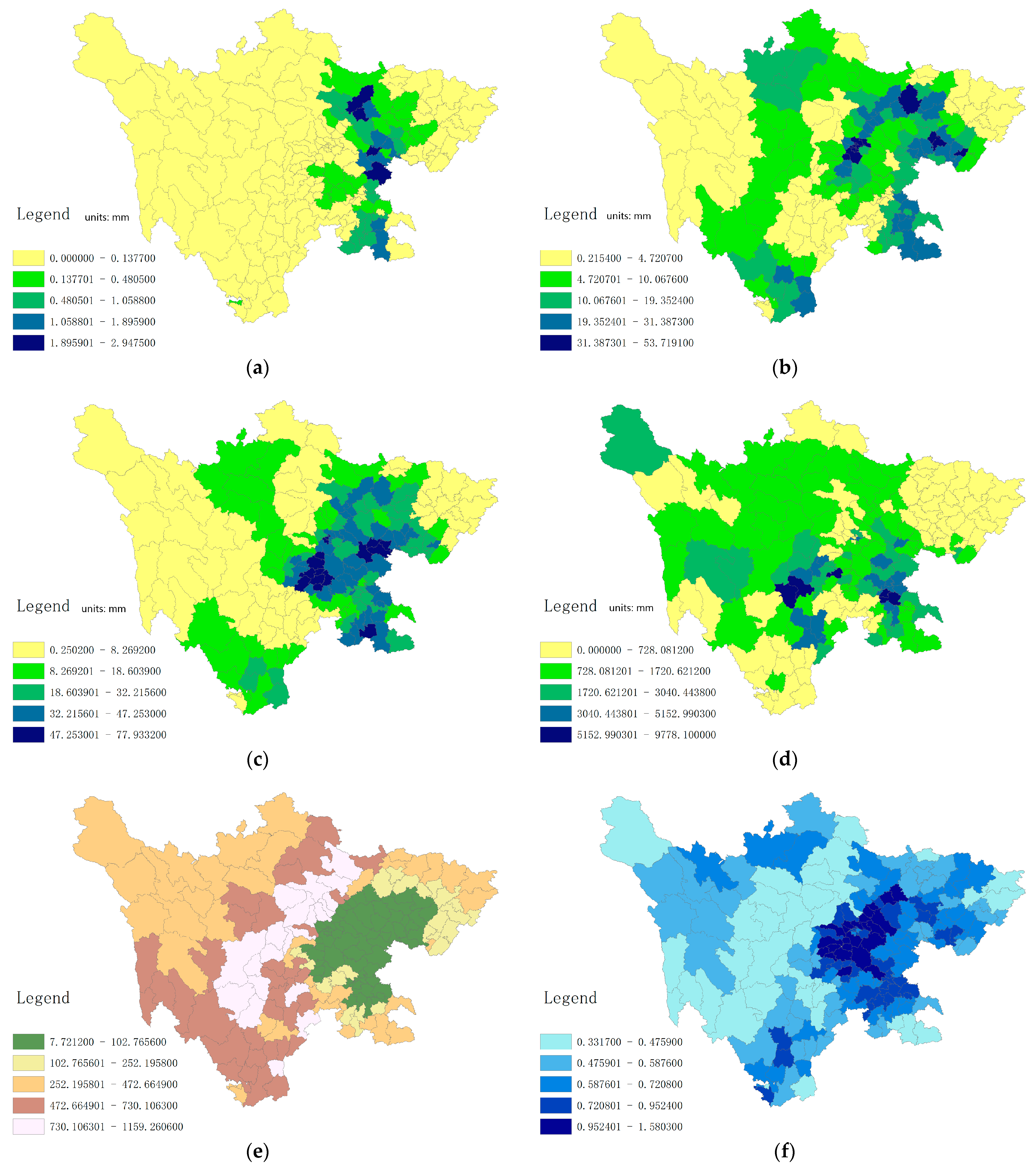

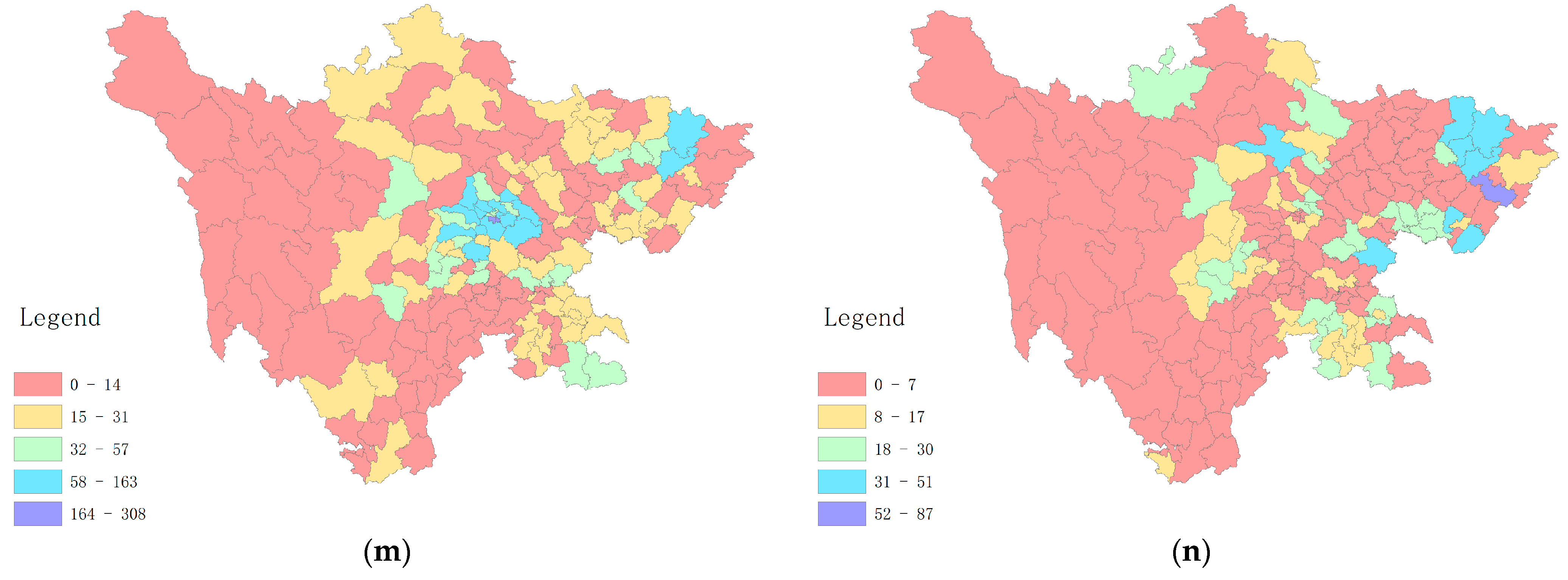
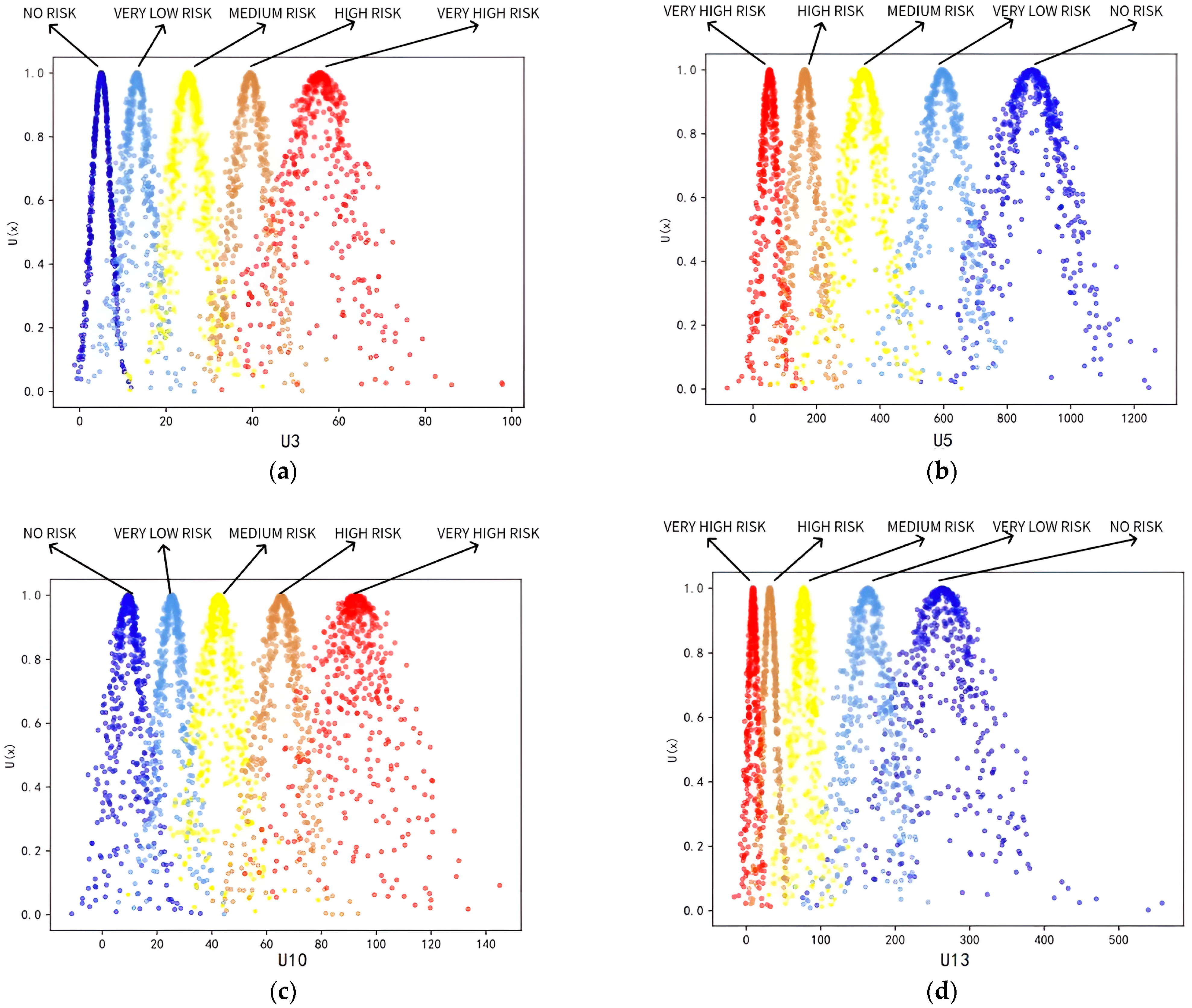
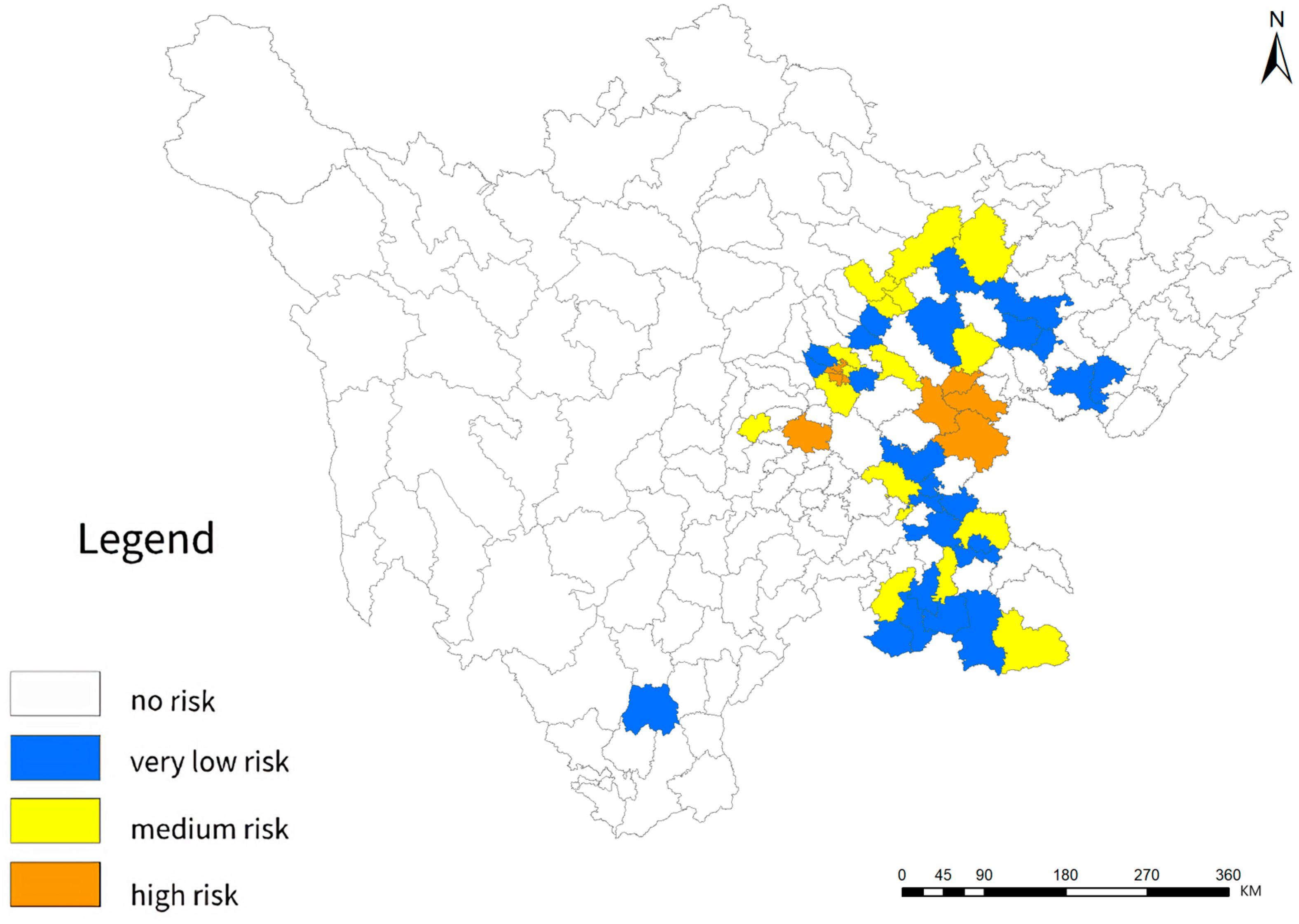

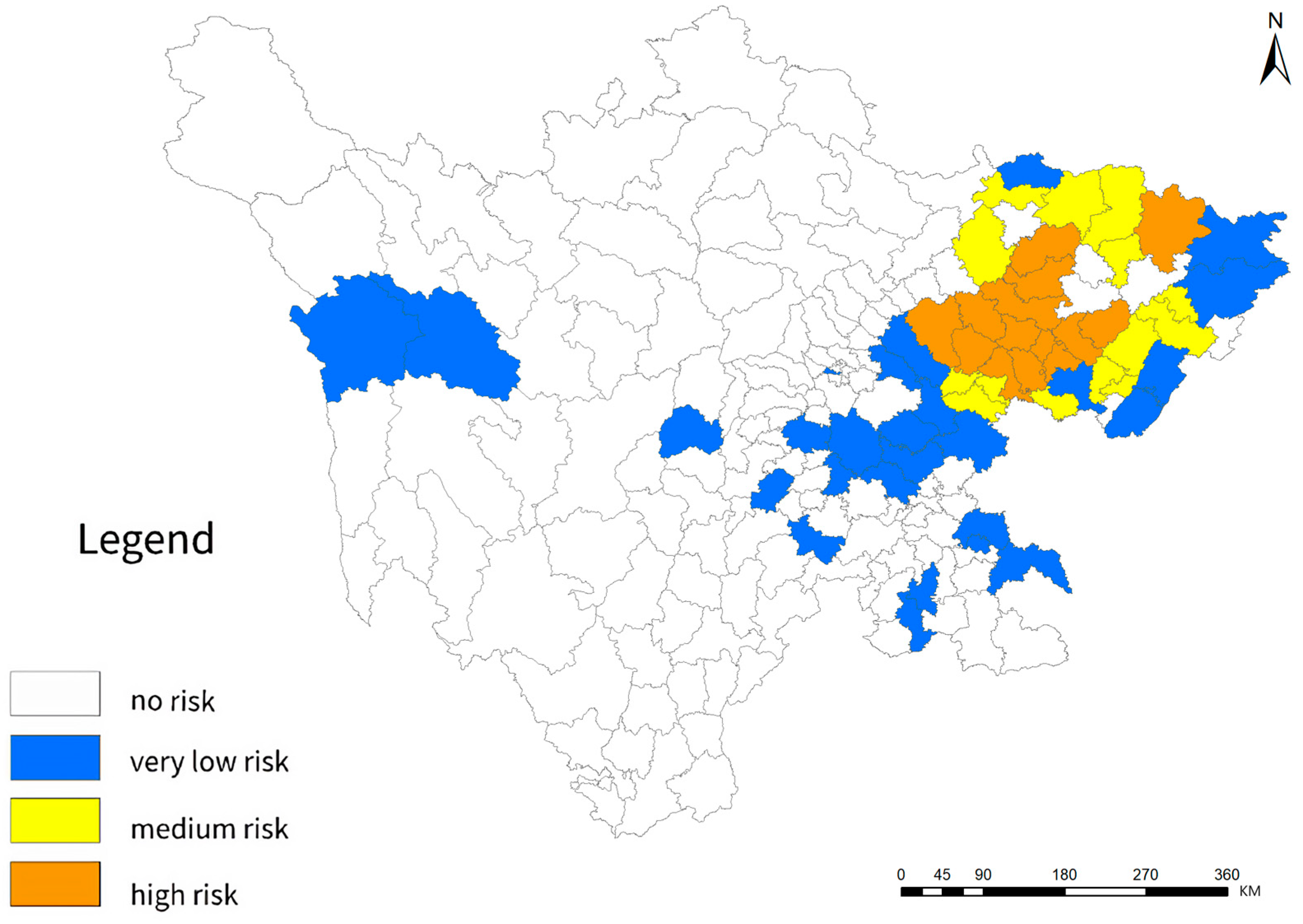
| Category | Indicator | Calculation Method | Correlation | Serial Number |
|---|---|---|---|---|
| disaster-causing factors | Precipitation for the previous 1 h | Precipitation for the previous 1 h/area | positive | U1 |
| Precipitation for the previous 12 h | Precipitation for the previous 12 h/area | positive | U2 | |
| Precipitation for the previous 24 h | Precipitation for the previous 24 h/area | positive | U3 | |
| Precipitation for the previous 5 days | Precipitation for the previous 5 days | positive | U4 | |
| disaster-conceiving environment | Standard deviation of elevation | negative | U5 | |
| River network density | Total river length/area | positive | U6 | |
| Number of flash flood hazard zones | Number of flash flood hazard zones | positive | U7 | |
| disaster-bearing body | Population density | Total population volume/area | positive | U8 |
| GDP density | Total GDP volume/area | positive | U9 | |
| Number of villages and towns along the river | Number of villages and towns along the river | positive | U10 | |
| Number of villages and towns affected by flash floods | Number of villages and towns 1 km from flash flood hazardous area | positive | U11 | |
| Number of hazardous chemical plants | Number of hazardous chemical plants | positive | U12 | |
| regional disaster resilience capacity | Number of rescue teams | Number of rescue teams | negative | U13 |
| Number of material warehouses | Number of material warehouses | negative | U14 |
| Indicator | No Risk | Very Low Risk | Medium Risk | High Risk | Very High Risk |
|---|---|---|---|---|---|
| U1 | 0.0000–0.1377 | 0.1377–0.5624 | 0.5624–1.2269 | 1.2269–1.8958 | 1.8958~ |
| U2 | 0.2154~6.6398 | 6.6398~15.9247 | 15.9247~27.1622 | 27.1622~40.6293 | 40.6293~ |
| U3 | 0.2502~8.9546 | 8.9546~18.6038 | 18.6038~32.2156 | 32.2156~47.2529 | 47.2529~ |
| U4 | 0.0000–671.5647 | 671.5647–1675.8150 | 1675.8150–2987.6875 | 2987.6875–5022.2132 | 5022.2132~ |
| U5 | 1159.2606–730.1063 | 730.1063–472.6649 | 472.6649–252.1958 | 252.1958–102.7656 | 102.7656~ |
| U6 | 0.3317–0.5285 | 0.5285–0.7112 | 0.7112–0.9385 | 0.9385–1.1988 | 1.1988~ |
| U7 | 0.0000–79.0000 | 79.0000–162.0000 | 162.0000–278.0000 | 278.0000–434.0000 | 434.0000~ |
| U8 | 4.4817–295.3065 | 295.3065–943.1672 | 943.1672–2653.9434 | 2653.9434–8644.5870 | 8644.5870~ |
| U9 | 3.7109–3718.8462 | 3718.8462–12,817.41 | 12,817.4100–24,847.9900 | 24,847.9900–89,061.2400 | 89,061.2400~ |
| U10 | 1.0000–17.0000 | 17.0000–34.0000 | 34.0000–54.0000 | 54.0000–78.0000 | 78.0000~ |
| U11 | 0.0000–83.0000 | 83.0000–176.0000 | 176.0000–299.0000 | 299.0000–454.0000 | 454.0000~ |
| U12 | 3.0000–16.0000 | 16.0000–35.0000 | 35.0000–59.0000 | 59.0000–102.0000 | 102.0000~ |
| U13 | 308.0000–219.0000 | 219.0000–109.0000 | 109.0000–53.0000 | 53.0000–20.0000 | 20.0000~ |
| U14 | 87.0000–51.0000 | 51.0000–30.0000 | 30.0000–18.0000 | 18.0000–7.0000 | 7.0000~ |
| Indicator | No Risk | Very Low Risk | Medium Risk | High Risk | Very High Risk |
|---|---|---|---|---|---|
| U1 | (0.0135, 0.0259, 0.0146) | (0.2993, 0.1204, 0.0418) | (0.8556, 0.1924, 0.0373) | (1.6119, 0.2436, 0.0619) | (2.5953, 0.4018, 0.1264) |
| U2 | (2.8692, 2.0870, 0.8268) | (10.5962, 3.2085, 1.4153) | (21.5811, 2.8964, 0.7160) | (32.8361, 4.0261, 1.2196) | (48.6857, 5.5945, 2.1812) |
| U3 | (5.0197, 2.2360, 0.1818) | (13.2427, 3.0634, 1.0714) | (25.1203, 3.8477, 1.1188) | (39.4833, 4.014, 1.1764) | (55.6064, 7.0220, 3.1144) |
| U4 | (288.1342, 218.1925, 87.7172) | (1134.1979, 308.0468, 105.3966) | (2268.6742, 390.7631, 97.8993) | (3889.4457, 521.0995, 110.7841) | (6870.6748, 1459.5093, 308.6206) |
| U5 | (876.9410, 107.5732, 35.0412) | (595.5089, 71.1196, 20.7734) | (348.4263, 62.7807, 22.3094) | (162.5734, 37.9990, 10.7352) | (52.2913, 26.2900, 9.1390) |
| U6 | (0.4593, 0.0457, 0.0054) | (0.6169, 0.0494, 0.0178) | (0.8064, 0.0693, 0.0260) | (1.0731, 0.0740, 0.0199) | (1.4087, 0.1519, 0.0637) |
| U7 | (42.1333, 28.3342, 11.5988) | (117.9437, 24.6416, 8.6041) | (209.2391, 32.7899, 10.6769) | (363.4000, 47.0494, 16.9884) | (535.0000, 78.2068, 40.6830) |
| U8 | (91.3559, 87.3037, 13.0714) | (504.2265, 149.7726, 2.5215) | (1563.4293, 523.8549, 182.7838) | (5649.2651, 3754.0792, 2262.9975) | (11,791.2108, 1883.9385, 210.9787) |
| U9 | (908.1125, 931.3529, 173.3850) | (7389.8493, 2788.6865, 1013.7188) | (18,437.3508, 4325.8637, 1245.1571) | (63,303.1645, 24,098.2071, 4986.6123) | (124,642.8009, 29,729.9139, 15,463.0437) |
| U10 | (9.4828, 5.2100, 2.1490) | (25.3600, 5.0494, 1.657) | (42.5424, 6.1488, 2.6745) | (65.2581, 7.3086, 2.3688) | (92.4500, 9.6881, 7.4691) |
| U11 | (44.2264, 28.8552, 9.0176) | (126.9306, 27.9733, 11.3466) | (224.4222, 35.3230, 13.6335) | (375.9231, 48.8718, 12.6156) | (551.7500, 91.8053, 52.3261) |
| U12 | (8.1379, 3.6601, 1.1751) | (24.8033, 5.7240, 1.3607) | (45.7500, 6.5437, 1.8960) | (71.8889, 12.7807, 3.2357) | (391.0000, 362.2078, 218.3426) |
| U13 | (263.5000, 55.7725, 33.6202) | (163.6667, 46.2334, 10.9834) | (76.8889, 12.7033, 5.8454) | (31.7447, 9.3252, 1.6515) | (9.2966, 6.0090, 2.2095) |
| U14 | (69.0000, 22.5597, 13.5992) | (37.8889, 5.6941, 1.7348) | (22.56, 3.8943, 1.4280) | (13.2500, 3.2551, 0.8612) | (2.0252, 1.4591, 0.5312) |
| Indicator | No Risk | Very Low Risk | Medium Risk | High Risk | Very High Risk |
|---|---|---|---|---|---|
| U1 | 0.0000 | 0.4136 | 0.1220 | 0.0006 | 0.0003 |
| U2 | 0.0000 | 0.0000 | 0.0006 | 0.7664 | 0.1054 |
| U3 | 0.0000 | 0.0000 | 0.0270 | 0.7735 | 0.0820 |
| U4 | 0.9329 | 0.0701 | 0.0003 | 0.0000 | 0.0008 |
| U5 | 0.0000 | 0.0001 | 0.0554 | 0.9464 | 0.0021 |
| U6 | 0.5797 | 0.1235 | 0.0052 | 0.0000 | 0.0004 |
| U7 | 0.0017 | 0.0486 | 0.7391 | 0.0119 | 0.0085 |
| U8 | 0.7787 | 0.0621 | 0.0586 | 0.3358 | 0.0000 |
| U9 | 0.7966 | 0.0833 | 0.0036 | 0.0472 | 0.0122 |
| U10 | 0.0000 | 0.0039 | 0.6945 | 0.0798 | 0.0179 |
| U11 | 0.0472 | 0.9968 | 0.0603 | 0.0003 | 0.0095 |
| U12 | 0.0000 | 0.0169 | 0.8847 | 0.1030 | 0.5288 |
| U13 | 0.0230 | 0.0309 | 0.0219 | 0.9964 | 0.0162 |
| U14 | 0.0702 | 0.0000 | 0.0006 | 0.0062 | 0.7135 |
| Metrics | U1 | U2 | U3 | U4 | U5 | U6 | U7 |
| Hj | 0.9978 | 0.9973 | 0.9972 | 0.9983 | 0.9979 | 0.9980 | 0.9979 |
| Wj | 0.0960 | 0.1163 | 0.1218 | 0.0745 | 0.0922 | 0.0850 | 0.0906 |
| Metrics | U8 | U9 | U10 | U11 | U12 | U13 | U14 |
| Hj | 0.9987 | 0.9989 | 0.9981 | 0.9982 | 0.9996 | 0.9996 | 0.9995 |
| Wj | 0.0576 | 0.0467 | 0.0822 | 0.0793 | 0.0187 | 0.0164 | 0.0226 |
Disclaimer/Publisher’s Note: The statements, opinions and data contained in all publications are solely those of the individual author(s) and contributor(s) and not of MDPI and/or the editor(s). MDPI and/or the editor(s) disclaim responsibility for any injury to people or property resulting from any ideas, methods, instructions or products referred to in the content. |
© 2023 by the authors. Licensee MDPI, Basel, Switzerland. This article is an open access article distributed under the terms and conditions of the Creative Commons Attribution (CC BY) license (https://creativecommons.org/licenses/by/4.0/).
Share and Cite
Liu, J.; Wang, K.; Lv, S.; Fan, X.; He, H. Flood Risk Assessment Based on a Cloud Model in Sichuan Province, China. Sustainability 2023, 15, 14714. https://doi.org/10.3390/su152014714
Liu J, Wang K, Lv S, Fan X, He H. Flood Risk Assessment Based on a Cloud Model in Sichuan Province, China. Sustainability. 2023; 15(20):14714. https://doi.org/10.3390/su152014714
Chicago/Turabian StyleLiu, Jian, Kangjie Wang, Shan Lv, Xiangtao Fan, and Haixia He. 2023. "Flood Risk Assessment Based on a Cloud Model in Sichuan Province, China" Sustainability 15, no. 20: 14714. https://doi.org/10.3390/su152014714
APA StyleLiu, J., Wang, K., Lv, S., Fan, X., & He, H. (2023). Flood Risk Assessment Based on a Cloud Model in Sichuan Province, China. Sustainability, 15(20), 14714. https://doi.org/10.3390/su152014714






